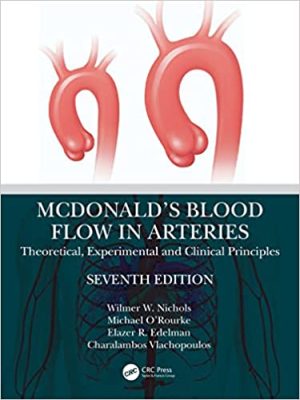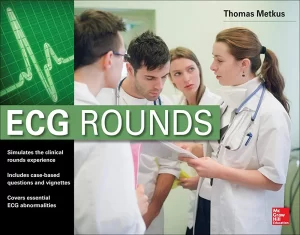Integrated Non-Invasive Cardiovascular Imaging: A Guide for the Practitioner (Non-serial Publications)
Integrated Non-Invasive Cardiovascular Imaging: A Guide for the Practitioner (Non-serial Publications)

Medical Books Library for Doctors, Physicians, Surgeons, Dentists, Intensivists, Physician Assistants, Nurses, Medical Technicians and Medical Students
Medical books library



This edition presents numerous new information, latest investigations, and management. Some new ECG strips have been incorporated and new explanations have been re-written in the light of recent updates in cardiology. This edition will help the students to prepare for both undergraduate and postgraduate examination and to develop their clinical competence and confidence in cardiology.

This book discusses all aspects of non-pharmacologic approaches to primary and secondary CVD prevention. It highlights the strength of evidence for particular diet styles in CVD prevention, including plant-based diets, the Mediterranean diet, the DASH diet, and low-carbohydrate diets. Chapters present evidence and future directions for diet and nutrition in diseases related to CVD, such as dyslipidemia, cardiometabolic disease (pre-diabetes, the metabolic syndrome, type-2 diabetes mellitus), and obesity. Finally, the book reviews novel and emerging aspects of dietary intervention in CVD prevention, such as dietary approaches to inflammation and the role of the microbiome in CVD.
Up-to-date, evidence-based, and clinically oriented, Prevention and Treatment of Cardiovascular Disease: Nutritional and Dietary Approaches is an essential resource for physicians, residents, fellows, and medical students in cardiology, clinical nutrition, family medicine, endocrinology, and lipidology.

For over sixty years, McDonald’s Blood Flow in Arteries has remained the definitive reference work in the field of arterial hemodynamics, including arterial structure and function with special emphasis on pulsatile flow and pressure. Prestigious, authoritative and comprehensive, this seventh edition has been totally updated and revised with many new chapters. This edition continues to provide the theoretical basis required for a thorough understanding of arterial blood flow in both normal and pathological conditions, while keeping clinical considerations and readability paramount throughout.
Key Features
Nuclear Cardiology and Multimodal Cardiovascular Imaging: A Companion to Braunwald’s Heart Disease
1st Edition

Recent years have seen numerous advances in cardiovascular nuclear medicine technology, leading to more precise diagnoses and treatment and an expanded understanding of the molecular basis for cardiac disease. Nuclear Cardiology and Multimodal Cardiovascular Imaging is a one-stop, comprehensive guide to the diagnostic and clinical implications of this complex and increasingly important technology. Part of the Braunwald family of renowned cardiology references, it provides cutting-edge coverage of multimodal cardiac imaging along with case vignettes and integrated teaching content―ideal for cardiologists, cardiology fellows, radiologists, and nuclear medicine physicians.
Features all the latest cardiovascular nuclear medicine studies with practical, evidence-based implications for personalized patient evaluation and treatment.
Presents a consistent, patient-centered approach using integrated case vignettes correlated with specific nuclear medicine imaging findings. Discusses patient assessment criteria, risk factor criteria, pathology, evaluation criteria, outcomes, and other clinical implications.
Covers a full range of imaging technologies, including SPECT/CT, PET/CT, and CT/MR hybrid radionuclide cardiovascular imaging studies.
Addresses emerging clinical applications of nuclear imaging techniques for precision-based medicine, including targeted molecular imaging and cell therapies.
Includes sections on instrumentation/principles of imaging; protocols and interpretation; applications in coronary artery disease, special populations, and heart failure; artificial intelligence, and more.
Contains guidelines and appropriate use documents to provide appropriate context for clinicians.
Features hundreds of high-quality figures including multimodal cardiac imaging studies, anatomic illustrations, and graphs.
Provides Key Point summaries, 50 procedural videos, and 100 multiple-choice questions and answers to reinforce understanding and facilitate review.
Enhanced eBook version included with purchase, which allows you to access all of the text, figures, and references from the book on a variety of devices


[amazon_link asins=’1496312600′ template=’ProductAd’ store=’aishabano-20′ marketplace=’US’ link_id=’45dc19fd-07b8-11e9-98d6-e5f50d309a67′]
An ideal reference for residents, fellows, practitioners, and nurse practitioners, Manual of Cardiovascular Medicine, 5th Edition is a concise, up-to-date overview of key topics in cardiology. Using a practical, outline format, this best-selling title presents evidence-based approaches to cardiovascular diagnosis, diseases, and treatment – perfect for daily practice or exam preparation.
Enhance Your eBook Reading Experience